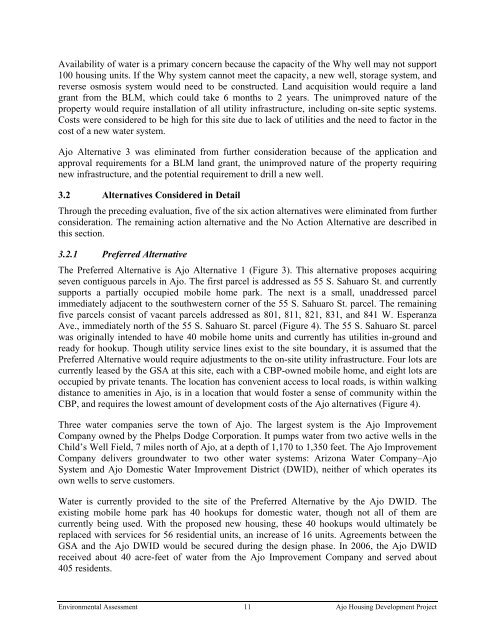US Customs and Border Protection Ajo Housing Development ... - GSA
US Customs and Border Protection Ajo Housing Development ... - GSA
US Customs and Border Protection Ajo Housing Development ... - GSA
You also want an ePaper? Increase the reach of your titles
YUMPU automatically turns print PDFs into web optimized ePapers that Google loves.
Availability of water is a primary concern because the capacity of the Why well may not support<br />
100 housing units. If the Why system cannot meet the capacity, a new well, storage system, <strong>and</strong><br />
reverse osmosis system would need to be constructed. L<strong>and</strong> acquisition would require a l<strong>and</strong><br />
grant from the BLM, which could take 6 months to 2 years. The unimproved nature of the<br />
property would require installation of all utility infrastructure, including on-site septic systems.<br />
Costs were considered to be high for this site due to lack of utilities <strong>and</strong> the need to factor in the<br />
cost of a new water system.<br />
<strong>Ajo</strong> Alternative 3 was eliminated from further consideration because of the application <strong>and</strong><br />
approval requirements for a BLM l<strong>and</strong> grant, the unimproved nature of the property requiring<br />
new infrastructure, <strong>and</strong> the potential requirement to drill a new well.<br />
3.2 Alternatives Considered in Detail<br />
Through the preceding evaluation, five of the six action alternatives were eliminated from further<br />
consideration. The remaining action alternative <strong>and</strong> the No Action Alternative are described in<br />
this section.<br />
3.2.1 Preferred Alternative<br />
The Preferred Alternative is <strong>Ajo</strong> Alternative 1 (Figure 3). This alternative proposes acquiring<br />
seven contiguous parcels in <strong>Ajo</strong>. The first parcel is addressed as 55 S. Sahuaro St. <strong>and</strong> currently<br />
supports a partially occupied mobile home park. The next is a small, unaddressed parcel<br />
immediately adjacent to the southwestern corner of the 55 S. Sahuaro St. parcel. The remaining<br />
five parcels consist of vacant parcels addressed as 801, 811, 821, 831, <strong>and</strong> 841 W. Esperanza<br />
Ave., immediately north of the 55 S. Sahuaro St. parcel (Figure 4). The 55 S. Sahuaro St. parcel<br />
was originally intended to have 40 mobile home units <strong>and</strong> currently has utilities in-ground <strong>and</strong><br />
ready for hookup. Though utility service lines exist to the site boundary, it is assumed that the<br />
Preferred Alternative would require adjustments to the on-site utility infrastructure. Four lots are<br />
currently leased by the <strong>GSA</strong> at this site, each with a CBP-owned mobile home, <strong>and</strong> eight lots are<br />
occupied by private tenants. The location has convenient access to local roads, is within walking<br />
distance to amenities in <strong>Ajo</strong>, is in a location that would foster a sense of community within the<br />
CBP, <strong>and</strong> requires the lowest amount of development costs of the <strong>Ajo</strong> alternatives (Figure 4).<br />
Three water companies serve the town of <strong>Ajo</strong>. The largest system is the <strong>Ajo</strong> Improvement<br />
Company owned by the Phelps Dodge Corporation. It pumps water from two active wells in the<br />
Child’s Well Field, 7 miles north of <strong>Ajo</strong>, at a depth of 1,170 to 1,350 feet. The <strong>Ajo</strong> Improvement<br />
Company delivers groundwater to two other water systems: Arizona Water Company–<strong>Ajo</strong><br />
System <strong>and</strong> <strong>Ajo</strong> Domestic Water Improvement District (DWID), neither of which operates its<br />
own wells to serve customers.<br />
Water is currently provided to the site of the Preferred Alternative by the <strong>Ajo</strong> DWID. The<br />
existing mobile home park has 40 hookups for domestic water, though not all of them are<br />
currently being used. With the proposed new housing, these 40 hookups would ultimately be<br />
replaced with services for 56 residential units, an increase of 16 units. Agreements between the<br />
<strong>GSA</strong> <strong>and</strong> the <strong>Ajo</strong> DWID would be secured during the design phase. In 2006, the <strong>Ajo</strong> DWID<br />
received about 40 acre-feet of water from the <strong>Ajo</strong> Improvement Company <strong>and</strong> served about<br />
405 residents.<br />
Environmental Assessment 11 <strong>Ajo</strong> <strong>Housing</strong> <strong>Development</strong> Project
















